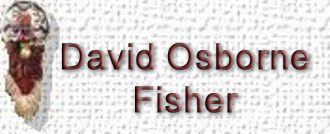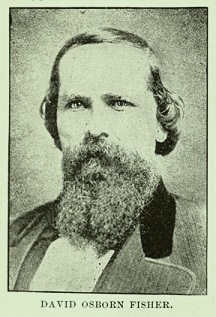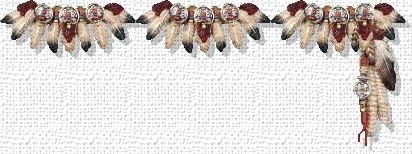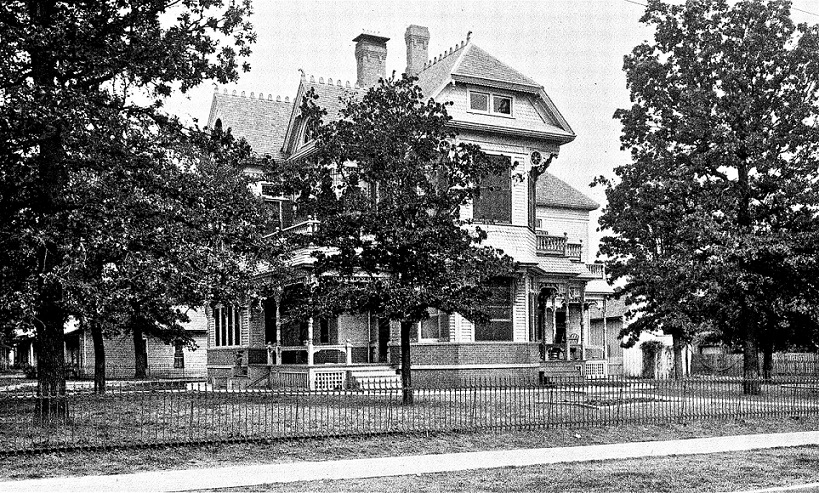  D. O. Fisher Source: Harry F. O'Beirne, Leaders and Leading Men of the Indian Territory, with Interesting Biographical Sketches, vol. 1: Choctaws and Chickasaws (Chicago: American Publishers Association, 1891); reprint Conway, AR: Oldbuck Press, 1994, page 36. Dr.
David Osborne Fisher In the early days of Denison, people influential in
the Choctaw and Chickasaw Nations of Indian Territory played important roles
south of the Red River. One of these was David Osborne Fisher. This profile was published in 1891: Osborn Fisher was born in August, 1850; is
the son of Joseph Fisher, a Kentuckian, and Martha Hayes, a Choctaw of the
Oka-la-fal-laya clan. He first saw the light on Pearl River, Mississippi, and
came to Fort Towsen, Choctaw Nation, in 1832. For three years he went to school at the
old Choctaw Academy under the supervision of Richard M. Johnson. In 1837 he
moved to Fort Washita and entered the employment of Gooding, who kept a trading
post and general supply store. After four years' service at that point, he
moved to Bok-tuk-kal-lo County, where he was employed in assisting Dan
Saftrons, who had a contract to feed a recently arrived emigration of Choctaws.
Five years afterward he moved to Panola County, on Red River, and opened a
large farm. At the age of twenty-three he married
Elizabeth Kemp, sister of Judge Ben Kemp, by whom he had six children, all of
whom are dead but Joseph, aged twenty-five years. At the youthful age of
twenty-one, Osborn Fisher was elected County Judge of Bok-tuk-kal-lo County,
and soon afterward served as representative of Kiamichi County at the Choctaw
Council. During the war he was quartermaster of the Choctaw and Chickasaw
regiment under Colonel Tandy Walker; after which, in 1865, he moved to
Sebastian County, Arkansas, where he opened a farm, cotton gin, etc. Three
years afterward he was burned out and moved to Perryville, and from there to
Briar Creek, Pickins County, where he went into the stock business, and then
moving from that point to Atoka, Choctaw Nation. Here he represented Atoka County
in the legislature, and in 1873 made his debut in Chickasaw politics by
representing Pickins County at the National Legislature. We should have previously stated that Mr.
Fisher was a member of both tribes, having been adopted by the Chickasaws
through an act of the legislature passed during the year. In the latter part of
1874 he was commissioned, in company with Col. Lem Reynolds, as a delegate to
Washington, which office frequently devolved upon him during the years which
followed. In 1877, while the subject of this sketch was living at Atoka, he was
again called to represent Pickins County at the Chickasaw National Council, and
two years afterward moved to the capital, at Tishomingo, disposing of his livestock
to Commissioner D. N. Robb, of Atoka, and the toll bridge to J. J. McAlester.
Having moved to the capital, Mr. Fisher purchased the mercantile business of
Byrd & Bro., in which branch he has continued. During the administration of Gov. Jonas
Wolf he was appointed National Interpreter, and National Treasurer in the Byrd
administration of 1888, which office he was forced to resign owing to an
overpress of business. Mr. Fisher has six hundred acres under cultivation and
gives employment to at least thirteen families. He married Mattie McSweeney in
1868, by whom he has three daughters — Mary, Agnes and Blanche, the eldest
being fourteen years of age. [Source: O'Beirne, Harry F.
Leaders and Leading Men of the Indian
Territory, with Interesting
Biographical Sketches ... Profusely Illustrated with Over Two Hundred
Portraits and Full-Page Engravings, vol. 1: Choctaws and
Chickasaws (Chicago: American Publishers Association, 1891); reprint, Conway, AR:
Oldbuck Press, 1994.]
Some additional information about Osborn Fisher
comes from the Internet, quoting Don Martini, Who Was Who Among the Southern Indians, 1698–1907: David Osborne Fisher, Choctaw, was born in 1825, the son of Joseph Fisher. He first married Elizabeth Kemp (1848–1966), a Chickasaw, and was listed on the 1857, 1858, and 1860 Chickasaw annuity rolls. Elizabeth was listed on the 1859 roll. She died in 1866. David then married Matilda Olive McSweeney (1850–1910), at Fort Smith, Arkansas, on September 24, 1868. He died October 24, 1898. Matilda was living in Tishomingo in 1907. His daughter, Agnes, married Benjamin H. Colbert.
Thus Fisher was related to the powerful Kemp and
Colbert families who operated ferries on the Red River north of Denison and
owned large acreages north of the river. In addition, Osborne was
brother-in-law of Judge Robert L. Boyd, who in 1891 was District Judge of the
Chickasaw Nation. Boyd was married to Matilda McSweeney's "full
sister" Mollie. Alexander Rennie was one of three brothers who had
come to the Chickasaw Nation from Canada and prospered greatly. Alex was National
Treasurer under William M. Guy, who won a hotly contested election for governor
in 1886. When William Byrd unseated him two years later, Rennie "transferred
his responsibility to D. O. Fisher."
Alex Rennie was a director of the State National
Bank in Denison in 1887. By 1891, he had become bank vice-president. He still
held this position in 1896 but was gone by 1901. When Charles S. Cobb was recruited from Michigan to form the First National Bank of Denison in 1890, Cobb served as president, and D. O. Fisher was vice-president. He retained this position through the consolidation of the First National Bank and the National Bank of Denison, serving until his death in 1898. At that time, another man from Indian Territory, J. J. McAlester, succeeded him as vice-president of the bank.
There was a commercial livery stable at the northeast corner of Woodard Street and Rusk Avenue, across from the Munson Block. Between 1891 and 1896, D. Osborne Fisher began operating a wagon yard here. He also sold wood and coal. Heavy traffic at this intersection made it a prime place to advertise products and coming events. Later, the Federal Building (Post Office) was constructed on this property.
Upon his death in October 1898, Osborn Fisher was buried in
the Tishomingo City Cemetery in Tishomingo, Oklahoma. His wife Matilda and
daughter Blanche Fisher Fleming are buried there, too. There is some indication
that Osborne's only living son, Francis Joseph, died around 1894.
Francis Joseph Fisher
[Chickasaw] The subject of this sketch is the only son of Hon. D. O.
Fisher, of Tishomingo. He was born in Panola County, Chickasaw Nation, and
completed his education at the Jesuit College, Osage Mission, Kansas. He spent the earlier part of his life taking charge of his
father's stock interests; after which he entered into partnership with his
father in the mercantile business till 1886, when he purchased the store of
Messrs. Byrd & Perry, of Tishomingo. His health becoming impaired by close application to
business, he sold out the following year and opened a large farm. He is now
residing seven miles southeast of the capital, where he owns 250 acres of good
farming land on the Washita bottom, and on which he makes three-quarters of a
bale of cotton and fifty bushels of corn to the acre. In September, 1884, he was appointed National Agent under
Gov. Jonas Wolf, which office he held till 1886. During Guy's administration
in 1887, he was appointed to the office of Inspector of Permits, and is now a
staunch adherent of the progressive party, while his father is looked upon as
one of the pillars of the National or Full-blood element. [Source: O'Beirne, Harry F.
Leaders and Leading Men of the Indian
Territory, with Interesting
Biographical Sketches ... Profusely Illustrated with Over Two Hundred
Portraits and Full-Page Engravings, vol. 1: Choctaws and
Chickasaws (Chicago: American Publishers Association, 1891); reprint, Conway, AR:
Oldbuck Press, 1994.]  Native American Roots Biography Index Grayson County TXGenWeb  Susan Hawkins © 2024  |



